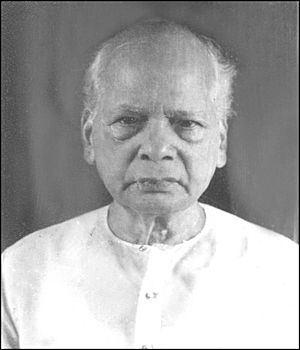Ramakrushna Nanda facts for kids
Quick facts for kids
Ramakrushna Nanda
|
|
|---|---|

Nanda during 1990s at Cuttack
|
|
| Born | 15 February 1906 Bairoi, Bengal Presidency, British India |
| Died | 28 October 1994 (aged 88) Cuttack, Orissa, India |
| Occupation | Teacher |
| Language | Odia |
| Nationality | Indian |
| Notable works | Ahe Dayamaya Biswa Bihari |
| Spouse | Saudamini Devi |
Ramakrushna Nanda (born February 15, 1906 – died October 28, 1994) was an Indian writer and teacher. He was famous for writing books and songs for children. He wrote the well-known song Ahe Dayamaya Biswa Bihari. This song was a favorite of Mahatma Gandhi. It was even part of Nanda's Odia language textbook called Sahitya Sopana.
Contents
About Ramakrushna Nanda
His Family Life
Ramakrushna Nanda's father was Madhusudan Nanda. His mother passed away in 1951. In 1925, Nanda married Soudamini Devi. They had eight daughters and one son together. His son, Er Prabhat Kumar Nanda, became a Chief Engineer. His daughter-in-law, Smt Anasuya Nanda, is also a writer and singer. She is the editor of Sansar, a children's magazine that Ramakrushna Nanda started.
His Education Journey
Nanda was born in Bairoi village in Odisha. He went to school in Kantapada and at Revenshwa collegiate school in Cuttack. He even wrote for a school magazine called Chandrika. During the time India was fighting for its freedom, Nanda was inspired by a leader named Gopobandhu. He became a Swecha Sebaka, which means a volunteer. He later studied at Satybadi Jatiya Bidyalaya. There, he learned Devnagiri, a type of Indian alphabet. Nanda also finished English medium school. He later earned a bachelor's degree in education.
His Career as a Teacher
Nanda started his career as a teacher at Banki school. For six years, he was an assistant teacher at Baripada high school. In 1933, Nanda became a social worker. He started a local group called Narayan Samiti to help people. He also worked as a headmaster at Bhingarpur high school.
His Writings and Songs
Writing Books
Nanda's first textbook in the Odia language was Sahitya Sopana. In 1946, he left his teaching job and moved back to Cuttack. On July 21, 1947, Nanda opened a printing press called Parijata press. In August 1952, he started a magazine called Sansar. This magazine was especially for children. The press closed in 1961. After retiring, Nanda continued to write many children's books and songs.
He wrote a special kind of rhyme called nanabaya, which are like nonsense rhymes. He believed that even if these rhymes didn't always make perfect sense, their rhythm and style were unique. He said that children loved these rhymes because they were fun and spontaneous.
Writing Song Lyrics
Ramakrushna Nanda also wrote lyrics for songs. Two of his songs, Aahe Dayamaya Bishwa Bihari and Holi Holi Re Holi Ranga Rangeli Nali, were used in the 1978 film Balidaan.
List of His Works
Here are some of the books and songs Ramakrushna Nanda wrote:
- 1930 – Tulsidas
- 1931 – Tulsidas Dohabali
- 1933 – Pratidhwani
- 1934 – 37 – Sahitya Sopana
- 1938 – Sahitya Bodha
- 1940 – Rachna Darpana
- 1944 – 45 – Patha Sopana
- 1936–46 – Sangram O Sadhana (Part 1 and Part 2)
- 1948 – Don Quixoti ( Translation )
- 1949 – Bigyanara Kuhuka
- 1962 – Biswa Parichaya (Oriya Bhasa Kosha)
- 1969 – Jibana Taranga.
- 1975 – Jhumuka
- 1977–84 – Chaati Gacha series (Athara Phula, Kodie Phula, Baisi Phula, Teisi Phula, Chabisi Phula, Subarna Seu, Marana Doli, Sagara Kanya)
- 1982 – Oriya Sishu sahitya and sangita Sankalana
- 1982 – Prakurtira Galpapuri
- 1982 – Indradhanu (translation)
- 1983 – Ama Bana Jangala Katha (translation)
- 1983 – Ama Sarira (translation)
- 1984 – Suna Pahacha
- 1984 – Ama Jatiya Pasu, Jatiya Pakhi
- 1985 – Ama Jatiya Pataka O Jatiya Sangita, Jatiya Puspa O Jatiya Pratika
- 1986 – Jibana Rahasya
- 1988 – Ratna Pakhuda (Part 1 and Part 2)
- 1989 – Satra Phula
- 1989 – Adekha Banara Phula
- 1989 – Pachatantra Kahani (Part 1, 2 and 3)
- 1992 – Lekhanira Pathasala
- 1993 – Bhabi Dekhantu
- 1994 – Tuntunira Bahi
- 1994 – Biswa Parichaya (2nd edition)

